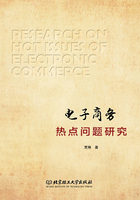
第五节 小结
随着我国电子商务的快速发展和人民物质水平的不断提高,消费者对电子商务的关注点从性价比向体验导向转变,对电商交易的期望越来越高。在这样的背景下,消费者对电子商务的投诉也日益增多,这种现象也就是电子商务的服务失败,而服务失败的发生又能引发消费者心理契约违背的感知,不利于电子商务的发展。本章着重围绕服务失败和心理契约违背这两个概念展开。
电子商务交易双方会对交易的内容以及交易双方的责任和义务有所期待,这种期待并没有明文规定或事前声明,这种就是我们所说的心理契约。当感知到的商品或服务质量没有达到预期时,消费者就感受到心理契约违背,从而引发信任度下降、忠诚度下降、拒绝购买、抱怨等不利影响。造成心理契约违背的原因主要有三种,分别是无力兑现、有意违背和双方理解歧义。在这三种之中,双方理解歧义发生的可能性最高,也是相对比较容易解决的情况,譬如我们可以通过信息的有效沟通来有效降低理解歧义的发生。
电子商务主要分为购前、购中和购后三个阶段,购前阶段主要包括信息收集、备选方案评价和选择等内容,购中阶段主要指交易的实现过程,如地址收集、支付等内容,购后阶段主要指交易实现后到消费者拿到货物,如果消费者发现货物出现问题,则还有相关的售后服务等内容。消费者的心理契约是一个动态形成的过程,伴随着电子商务流程的推进,消费者获取到不同的信息,从而形成和更新心理契约。影响消费者心理契约的因素主要包括社会因素(如社会影响、行业标准和法律法规)、电商平台因素(如平台声誉和平台争议处理机制)、商家因素(如商家信誉、宣传信息和客服人员沟通)以及消费者个体因素。
服务失败是与心理契约违背密切相关的一个概念,它指的是电子商务网站出现的信息失误、功能缺陷、系统故障等负面事件,这些负面事件会导致电子商务网站不能向用户提供完成交易活动所必需的技术能力(Tan等,2016)。服务失败主要包括三个维度,分别是信息失败、功能失败和系统失败。本章相关小节已经对各维度以及下属子维度进行了详细的解释。
作为电子商务交易双方信息中介的电商平台,它们有责任采取相应的机制来减少服务失败的出现,从而降低消费者心理契约违背的发生。本章以淘宝网为例,通过头脑风暴法总结了淘宝网推出的与服务失败的各维度密切相关的机制。同时进行了问卷调查,以期望从这些机制中提炼出因素,用于作为今后电商平台构建服务失败应对机制的理论指导。通过主成分分析,我们从这些应对机制中提炼出七个服务机制有效性因素,分别是信息更新、信息来源、信息筛选、服务补救、安全与隐私、商品推荐和阿里巴巴特色。
此外,本章还探讨了这些服务机制有效性因素对服务失败和心理契约违背的影响,结论表明有效地发挥信息更新、信息筛选、服务补救、商品推荐和阿里巴巴特色相关服务机制的作用能够显著地减少服务失败的发生,从而降低心理契约违背的出现。信息来源、安全与隐私两个因素并不能帮助减少服务失败的发生。这具有其合理性,信息来源的增多往往导致信息不一致现象的出现,并不能降低电子商务的不确定性,而且淘宝网推出多个信息来源更重要的目的是增加流量;此外,电子商务存在安全与隐私和便利性之间的权衡,我们存在用隐私换便利的考量,所以结果不显著也具有其合理性。
本章详细介绍了服务失败和心理契约违背的相关内容,总结了服务失败和心理契约违背对电商发展的不利影响,从而提醒从业者关注这两个问题。本章还总结了若干机制,为电子商务从业者减少服务失败提供指导,具有重要的理论和实践意义。
参考文献
[1]陈红.网购环境下基于心理契约违背的顾客抱怨行为研究[D].济南:山东大学,2013.
[2]程长.电子商务情景下心理契约违背对建言行为影响的研究[D].长沙:湖南师范大学,2012.
[3]电子商务研究中心.2017年度中国电子商务用户体验与投诉监测报告[R].杭州:电子商务研究中心,2018.
[4]范钧,杨丽钗.服务消费情境中的顾客心理契约形成机制研究[J].江苏商论,2009(2):30-32.
[5]冯颖如,程新伟.国内营销情景下顾客心理契约研究综述[J].重庆理工大学学报(社会科学版),2017,31(7):73-80.
[6]何明娟.C2C电子商务环境下服务失败归因及补救研究[D].成都:西南交通大学,2012.
[7]雷永莉.网络零售业服务失败归因及补救实证研究[D].天津:天津财经大学,2013.
[8]李原.心理契约违背的理论模型及其应用[J].经济与管理研究,2006(8):82-85.
[9]申学武,聂规划,沈凌.电子商务情境中的心理契约及其测量[J].科技进步与对策,2007(2):164-167.
[10]王颢越.服务失败、服务补救、感知公平及补救绩效的关系[D].杭州:浙江大学,2005.
[11]王婧.服务失败、关系类型对服务补救预期及补救绩效的影响[D].西安:西安交通大学,2006.
[12]谢利平.基于公平理论的服务补救研究[D].长春:吉林大学,2008.
[13]阳林,李青.基于心理契约违背的顾客抱怨管理策略研究[J].中国集体经济,2008(7):60-61.
[14]章莹.网络背景下的服务失败与补救研究[D].杭州:浙江大学,2010.
[15]Bin M, Nirup MM, Sumit S. No free lunch:price premium for privacy seal-bearing vendors[J]. Journal of Management Information Systems,2010,27(2):189-212.
[16]Boroumand L, Aghdasi M, Albadvi A, et al. Service failure[J]. Iranian Journal of Information Science and Technology,2008,6(2).
[17]Buttle F, Burton J. Does service failure influence customer loyalty[J]. Journal of Consumer Behaviour,2002,1(3):217-227.
[18]Colgate M, Norris M. Developing a comprehensive picture of service failure[J]. International Journal of Service Industry Management,2001(12):215-233.
[19]Choi S, Mattila A S. Perceived controllability and service expectations:influences on customer reactions following service failure[J]. Journal of Business Research,2008,61(1):24-30.
[20]Herriot P, Pemberton C. Contracting careers[J]. Human Relations, 1996(49):757-790.
[21]Hess R L, Ganesan S. Service failure and recovery:the impact of relationship factors on customer satisfaction[J]. Journal of the Academy of Marketing Science,2003,31(2):127-145.
[22]Johnston R. Service failure and recovery:impact, attributes and process[M]. Greenwich:JAI Press,1995:211-228.
[23]Mohr L A, Bernhardt K L, Harris K E. Online service failure, consumer attributions and expectations[J]. Journal of Services Marketing,2006, 20(7):453-458.
[24]Morrison E W, Robinson S L. When employees feel betrayed:a model of how psychological contract violation develops[J]. Academy of Management Review,1997,22(1):226-256.
[25]Nikbin D, Ismail I. The impact of causal attributions on customer satisfaction and switching intention:empirical evidence from the airline industry [J]. Journal of Air Transport Management,2012,25(1):37-39.
[26]Pavlou P A, Gefen D. Psychological contract violation in online marketplaces:Antecedents, consequences, and moderating role[J]. Information Systems Research,2005,16(4):372-399.
[27]Piccoli G, Spalding B R, Ives B. The customer-service life cycle:a framework for improving customer service through information technology[J]. Cornell Hotel and Restaurant Administration Quarterly,2001,42(3):38-45.
[28]Rigyris I C. Understanding organizational behavior[M]. London:Tavistock Publications,1960.
[29]Roehling M V. The origins and early development of the psychological contract construct[J]. Journal of Management History,1997,3(2):204-217.
[30]Rousseau D M. Psychological and implied contracts in organizations [J]. Employee Responsibilities and Rights Journal,1989,2(2):121-139.
[31]Sajtos L, Brodie R. Impact of service failure:the protective layer of customer relationships[J]. Journal of Service Research,2010,13(2):216-229.
[32]Seungoog W, Sharon E B, Michael A J. The impact of service failure severity on service recovery evaluations and post-recovery relationships[J]. Journal of Services Marketing,2004,18(2):133-146.
[33]Tan C W, Benbasat I, Cenfetelli R T. An exploratory study of the formation and impact of electronic service failures[J]. MIS Quarterly,2016,40(1):1-29.
[34]Wan L C. Culture's impact on consumer complaining responses to embarrassing service failure[J]. Journal of Business Research,2013,66(3):298-305.
[35]Wang Y S, Wu S C, Lin H H, et al. The relationship of service failure severity, service recovery justice and perceived switching costs with customer loyalty in the context of e-tailing[J]. International Journal of Information Management,2011,31(4):350-359.
[36]Weber K, Sparks B. Service failure and recovery in a strategic airline alliance context:interplay of locus of service failure and social identity[J]. Journal of Travel and Tourism Marketing,2010,27(6):547-564.
[37]Weber K, Sparks B, Hsu C H C. The effects of acculturation, social distinctiveness, and social presence in a service failure situation[J]. International Journal of Hospitality Management,2016(56):44-55.
[38]Zhang K Z K, Benyoucef M. Consumer behavior in social commerce:a literature review[J]. Decision Support Systems,2016(86):95-108.
附录:量表
